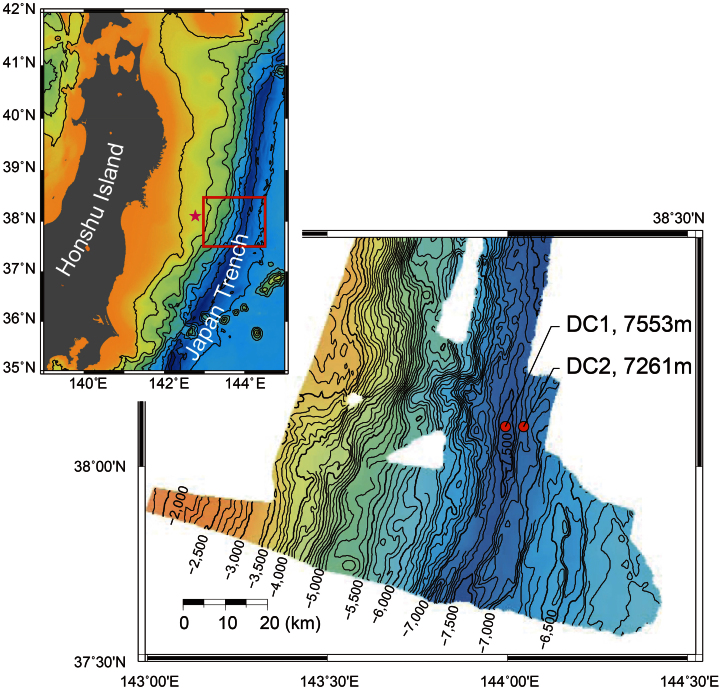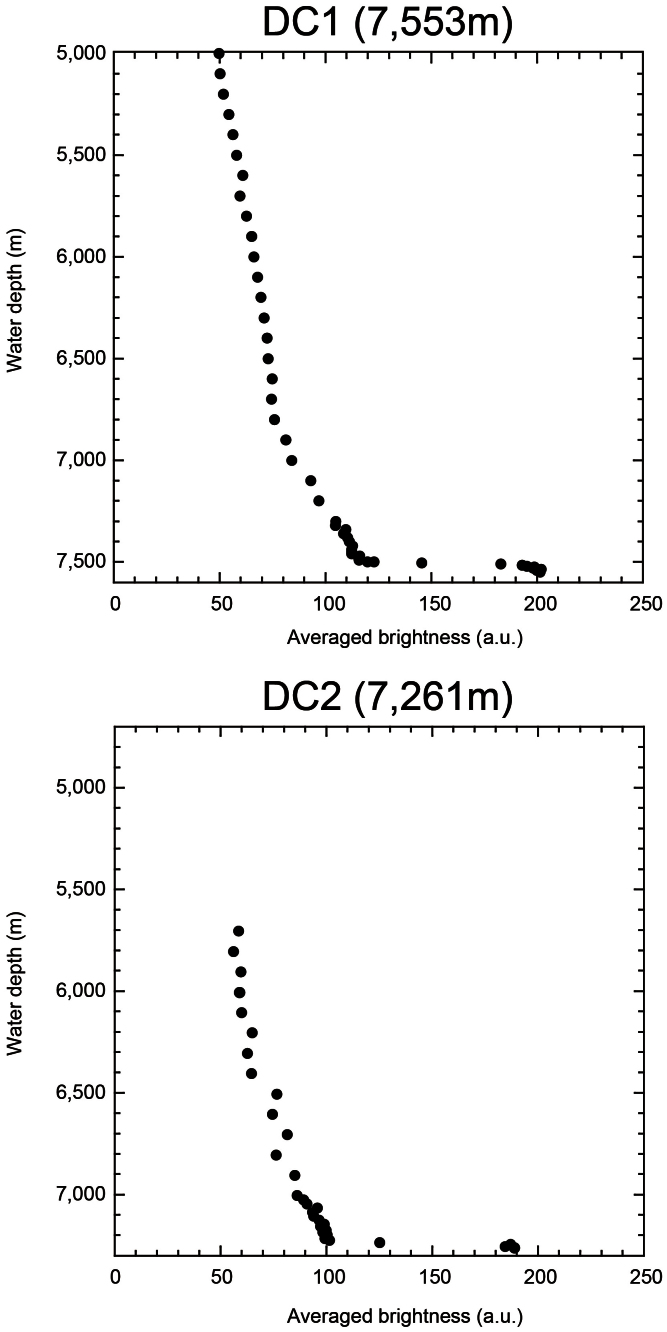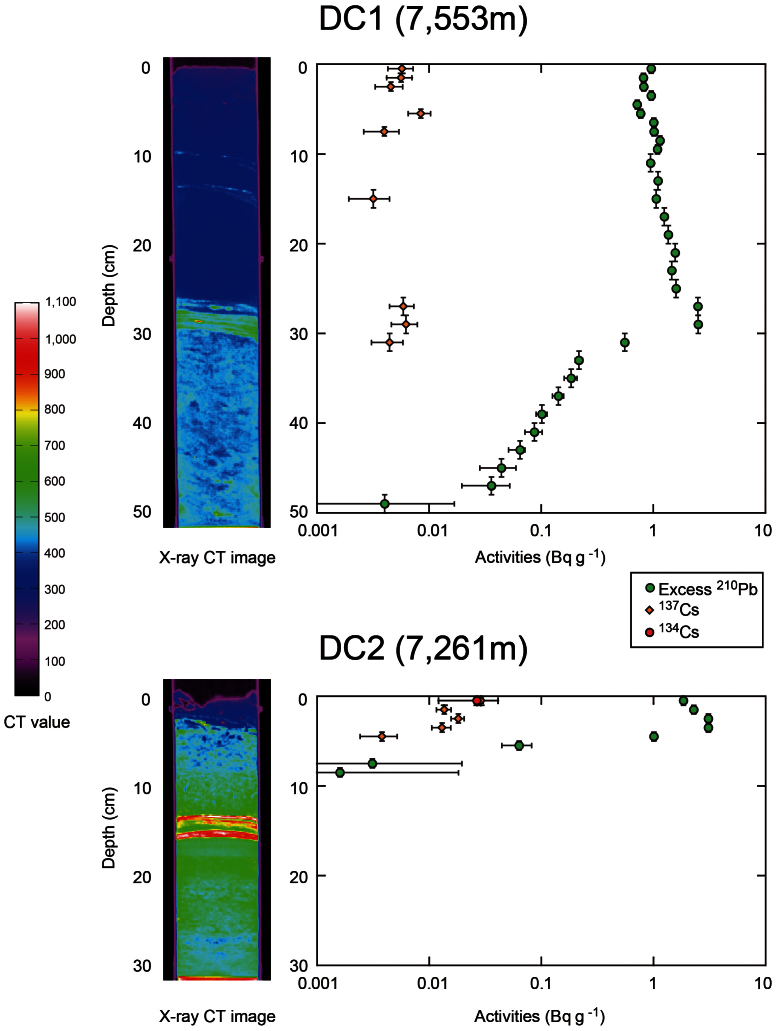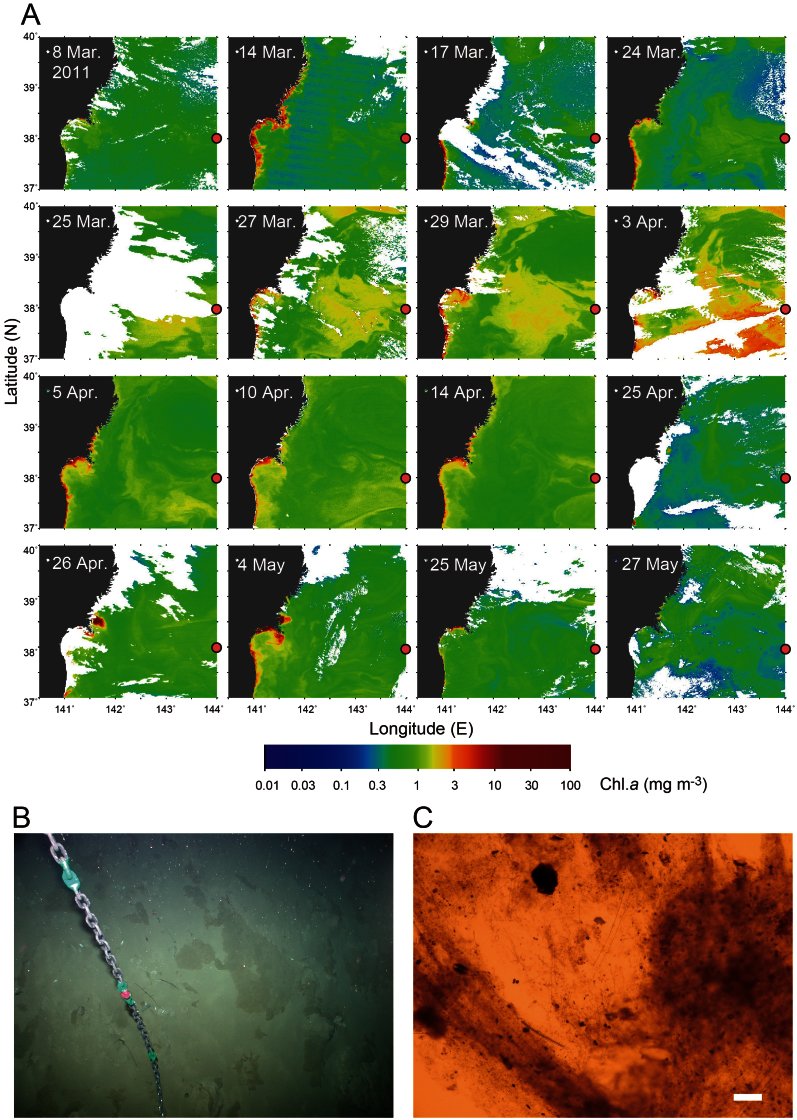Abstract
In situ video observations and sediment core samplings were performed at two hadal sites in the Japan Trench on July, 2011, four months after the Tohoku–Oki earthquake. Video recordings documented dense nepheloid layers extending ~30–50 m above the sea bed. At the trench axis, benthic macrofauna was absent and dead organisms along with turbid downslope current were observed. The top 31 cm of sediment in the trench axis revealed three recent depositions events characterized by elevated 137Cs levels and alternating sediment densities. At 4.9 km seaward from the trench axis, little deposition was observed but the surface sediment contained 134Cs from the Fukushima Dai–ichi nuclear disaster. We argue that diatom blooms observed by remote sensing facilitated rapid deposition of 134Cs to hadal environment and the aftershocks induced successive sediment disturbances and maintained dense nepheloid layers in the trench even four months after the mainshock.
The Tohoku–Oki earthquake (Mw = 9.0) occurred at 05:46 Coordinated Universal Time (UTC) on the 11th of March, 2011 off the northeast coast of Japan, and caused significant topographic changes to the sea floor1,2. This included a horizontal sea floor displacement of 24 m and a 3 m vertical displacement at the central epicenter3. The earthquake also caused physical and geochemical changes including displacement of reduced sediments from the trench slope towards the central basins, where they supposedly induce significant environmental stress for the benthic habitats4,5. However, no one has previously performed direct visual and environmental investigations at the hadal sea floor just after a major earthquake. This is mainly due to technical and logistic difficulties in a highly impacted society. Recently, direct observation of such hadal environments has been enabled by the development of in situ instrumentation; where a high definition television (HDTV) video camera, a conductivity depth temperature profiler (CTD) and a sediment core sampler were mounted on an aluminum tripod equipped with syntactic foam, ballast weights, and an acoustic releaser for autonomous deployments6. Four months after the 2011 Tohoku–Oki earthquake, Japan Agency for Marine-Earth Science and Technology (JAMSTEC) conducted cruise to the Japanese Trench. The ship, R/V Yokosuka visited the trench between 11th and 27th of July 2011 (YK11–E06, Leg. 1). During the cruise, our in situ instrument was deployed at two positions within the hadal Japan Trench: at the deepest trench site (DC1, 7,553 m) and seaward of the trench at DC2 (7,261 m) (Figure 1). DC1 was positioned 110 km from the epicenter of the mainshock and the two stations were 4.9 km apart. In this paper we report the first results documenting drastic environmental changes in the trench as assessed by video inspections, X-ray computed tomography (CT) analysis and sediment profiles of artificial and natural radionuclides. The transportation pathway of fallout from the Fukushima Dai–ichi nuclear disaster to the hadal environment is evaluated and discussed.
Figure 1. Map of the sampling sites.
DC1 (38°05′1595″ N, 143°59′4545″ E, water depth 7,553 m) is positioned on the trench axis, and the DC2 (38°05′1190″ N, 144°02′6174″ E, water depth 7,261 m) is positioned on the seaward slopes of the trench. Star in the left map represents the epicenter of the 2011 Tohoku–Oki earthquake. The enlarged map was derived from acoustic survey during the YK11–E06 cruise.
Results
Nepheloid layers in the bottom water of the trench
The video records revealed a dense nepheloid layer at both deployment sites. As no hadal depth graded nephelometer has been developed, the sea floor disturbance and the associated sediment suspension (i.e. the thickness of bottom nepheloid layers) were analyzed from videos recorded during the descent of the instrument. The average brightness of the images at DC1 showed a gradual increase from 7,000 m depth, followed by an abrupt increase 50 m off the sea bed. At DC2, the gradual increase of image brightness was seen from 6,400 m, and it drastically increased 30 m above the sea floor (Figure 2). Similar observations were made at the plains and slopes off Tohoku (water depth; 2,000–5,000 m) one month after the mainshock4. Our recordings show that intense suspension still persisted in the hadal trench three months later. This result is consistent with the previous sediment trap studies in the Japan Trench where elevated sediment deposition was documented for several months after larger earthquakes7,8. By the 12th of July 2011, some 4 months after the Tohoku–Oki Earthquake, the Japan Meteorological Agency had observed 666 aftershocks that exceeded 5.0 in Mw (Statistical data http://www.seisvol.kishou.go.jp/eq/2011_03_11_tohoku/aftershock/ in Japanese. English version without statistical data is available at http://www.jma.go.jp/jma/en/2011_Earthquake/Information_on_2011_Earthquake.html). Repeated disturbance by these aftershocks most likely maintained the observed nepheloid layer inside the trench.
Figure 2. Profiles of the averaged brightness of the images taken in the water column.
The averaged image brightness intensified with increasing turbidity of the water column.
Sea bed environments and benthic habitats
The in situ video observations reveal intense turbidities and formation of long lasting, dense and thick nepheloid layers above the sea bed. Furthermore, video records show downslope currents driving particle transport towards the deepest region of the trench. The main turbidity component in the trench consists of fine–grained sized particles rather than aggregated biogenic matter, and current ripples mark the sediment surface were observed (Supplementary video). Benthic organisms such as cnidaria, annelida or holothuria, which commonly inhabit the hadal zone9,10,11,12 were absent and only a few unidentified amphipods and fish were observed We also observed fragments of deep–sea jellyfish and holothuria being carried by the strong currents. Carcasses of benthic fauna may have been embedded in the redeposited trench sediment thereby forming subsurface carbon–enriched microbial hot spots. Furthermore, enhanced deposition of organic material at the trench base was intensified by horizontal material transport along the trench slope13.
Elevated turbidity was also observed at DC2, but the particle density was lower than at DC1. Unlike DC1, filamentous–shaped biogenic matter was the dominant component of the suspended particulate material. The sea floor at the DC2 landing site was flat and ripple marks were absent. However, here the abundance of amphipods was significantly higher. These observations suggest that the disturbance triggered by the earthquake were smaller at DC2 as compared to the situation at DC1. At both sites, the continued recordings revealed fluctuating turbidity-levels in the bottom water and no distinct attenuation in the values could be observed.
X-ray CT scan and radionuclide analyses
Analysis of sediment cores recovered from DC1 and CT scans show that the top 29.5 cm be was composed of a low–density dark, olive–brown, silty clay, with three distinct high–density layers at 10.5, 14, and 29.5 cm depth. The dominant components of these dense layers are sponge spicules, volcanic glass, silt–/sand–sized feldspar and quartz grains. Below 30 cm, the sediment transforms to a more dense olive–black, silty clay with relict burrows of benthic infauna. The DC2 sediment core, by contrast, has a 4–5 cm thick low–density cap overlying a denser 18 cm unit of dark olive to olive–brown silty clay. At 14 cm is another high density layer of silty sand and volcanic grains including glass, feldspar and hornblende.
Typically, 137Cs is only present in the upper 6–8 cm of deep–sea sediments in the north Pacific14,15, but in the DC1 core, 137Cs penetrated to a depth of 31 cm (Figure 3). This 31 cm–thick sediment layer was also characterized by high levels of excess 210Pb concentration.
Figure 3. Pseudocolor X-ray CT images and the 137Cs, 134Cs, and excess 210Pb profiles in two recovered cores.
The range of the CT values in the image is from 0 to 1,100 (AU). The error bars in the radionuclide concentrations represent two standard deviations of the peak counting error.
The surface low–density layer in the DC2 core was at most 5 cm as inferred from the 137Cs penetration depth and the excess 210Pb profiles (Figure 3). Below 4 cm, however, the excess 210Pb concentration decreased rapidly and was below the detection limit at 10 cm. These data imply limited sediment deposition at DC2 after the mainshock. We argue that the high density layer at ~14 cm, derived of excess 210Pb, was formed much earlier than the Tohoku–Oki earthquake. Smear slide observations from this layer also documented that sand–sized particles including volcanic glass were dominant and therefore, the layer most likely originates from a past volcanic eruption16.
Remarkably, we detected 134Cs (T1/2 = 2.06 years) in the top 0–1 cm at DC2 (Figure 3). This material can only originate from the Fukushima Dai–ichi nuclear power plant disaster that occurred at 13th March 2011. This nuclide was not detected at any depths at DC1.
Discussion
The in situ video recordings and the sediment analyses document successive disturbances in the deepest part of the Japan Trench since the Tohoku–Oki earthquake on the 11th of March 2011. Dense nepheloid layers remained 4 months after the main shock and were presumably maintained by aftershock induced transportation of gravitational unstable surface sediment from the trench slopes17. Benthic habitation (i.e., epifaunal and infaunal recolonizations) after the shocks was low and, as observed from the video recordings at both sites, only nektonic fauna (amphipods, swimming polycheatea and fish) survived the disaster. This will have a major impact on biological and biogeochemical functioning of sediments in the Japan Trench for many years to come18.
Altogether the X-ray CT scans and the radionuclides data strongly suggested that the top 31 cm of sediment was deposited recently and within a very short time. We argue based on the sedimentary data that at least two alternations of thin–high dense and thick–low dense layers within the upper 31 cm reflect successive deposition events induced by aftershocks. We only detected 134Cs activity at the sediment surface of DC2 (Figure 3). We argue that this is a genuine signal and not related to contamination. This can be ruled out because atmospheric fallout had ceased by late April 201119, and all instrumentation was kept indoor before and during the cruise. The maximum activity of 134Cs in surface waters during April to June 2011 were <0.0003 Bq g−1 20,21 and no 134Cs concentration could be detected at water depths below 300 m. Furthermore, values in collected plankton amounted to 0.0046 Bq g−1 21. Both levels being orders of magnitude below the values we detected in the surface sediments. We therefore argue that the benthic signals could not have been the result of contamination during the instrument's decent. Background radiation spectra in the laboratory held no 134+137Cs peaks documenting a clean environment during sediment handling and measurements. This evidence supports that the 134Cs levels in surface sediments at DC2 not were induced by contamination.
The distance between DC1 and DC2 was only 4.9 km, and obviously any primary deposition of 134Cs at the two sites must have been very similar20,21. We therefore argue that the extensive sediment deposition and associated mixing observed at DC1 has diluted the original 134Cs sediment signal below our detection limit. This is supported by a report of turbidite structures found in sediments collected around the epicenter area (http://www.u-tokyo.ac.jp/public/public01_231020_j.html), and subsurface maxima of 134+137Cs concentration recorded in cores collected at 122 m to 5,522 m water depth (https://gsa.confex.com/gsa/2012AM/finalprogram/abstract_206341.htm). While the 137Cs and excess 210Pb profiles at DC1 clearly indicate major and recent deposition events, the sediments at DC2 exhibited no such characteristics and therefore the surface sediment maintained the 134Cs signal. The 134Cs–containing particles must have been transported quickly from the surface waters to the sediment of the hadal trench. We speculate that this transport was facilitated by a concurrent spring bloom of phytoplankton that occurred between 25th of March and 10th of April 2011, as can be observed by satellite remote sensing (Figure 4a). Indeed, a deep–tow camera observation on 8th of June 2011 during YK11–E04, Leg. 1 cruise by R/V Yokosuka (between 3rd to 13th of June 2011), confirmed the existence of deposited phytodetritus aggregations at the trench slope down to the deepest investigated stations (at 38°10′ N, 143°47′ E, water depth of 5,800 m; Figure 4b). Microscopic observations identify abundant diatom frustules in this material (Figure 4c). As the first major fallout took place between the 22nd and the 30th of March 201119, the sinking speed of the phytodetritus and fallout material to the trench slope site and hadal depths of the Japan Trench can be estimated at a minimum of 78 and 64 m day−1, respectively. This speed is comparable to the results of studies in the Black Sea following fallouts from the Chernobyl accident22 and aligns to sinking speed of large phytodetritus material23.
Figure 4. Phytoplankton blooming indicated by remote sensing and phytodetritus from the sea bed in Japan Trench on June 2011.
(A): The Chlorophyll a concentration images taken from the Moderate Resolution Imaging Spectroradiometer (MODIS) instrument on board the Aqua satellite (courtesy of NASA, JAXA/EORC and Tokai University). The red circles in the images involve the sites, DC1 and DC2. (B): Phytodetritus aggregations covered on sea bed observed by a deep–tow camera system. The aggregations are identified as dark olive–green materials. (C): Microscopic photograph of phytodetritus collected by dredge sampling. Frustules of Nitzschia sp. were dominating. Scale bar length represents 100 μm.
The combined evidence supports the idea of efficient vertical transport of the fallout nuclides with phytoplankton material – a signal that can be masked by subsequent turbidites and sediment displacement. We cannot exclude that the nepheloid layers also contained some suspended 134Cs containing material. Clearly the local deposits can be resuspended by the aftershocks, but larger fast sinking aggregates will quickly redeposit.
Methods
Deployments of in situ instrumentation and sediment core sampling
The detailed operation scheme of the in situ instrumentation is described in reference 6. The tripod held a HDTV video camera (Handycam, Sony, Japan) mounted in a pressure-stable cylinder and two halogen lights (Deep SeaLite, Deep Sea Power & Light, USA). Furthermore, the frame included a CTD (SBE49, Sea–Bird Electronics, USA) and three sediment core samplers (core length of 60 cm and inner diameter of 72 mm, Rigosha, Japan). Additional sediment material is archived at JAMSTEC.
Measurement of bottom nepheloid layer thickness
The averaged brightness of each image extracted from the video sequences was calculated using MATLAB and image processing toolbox (MathWorks, USA). The exact water depths were recorded by the CTD–instrument and were aligned to the time stamp of the respective images.
X-ray CT analysis and smear slide observation of the sediment cores
Collected sediment cores were refrigerated on board. In the laboratory, X-ray CT images were taken by a CT scanner (Pratico, Hitachi, Japan). After the scanning, the cores were split vertically and one section was used for lithology descriptions. Microscopic smear slide observations were carried using a polarized light microscope (CX31P, Olympus, Japan).
Radionuclide analyses of the sediment samples
The split sediment cores were sectioned into 1 cm slices from zero to 10 cm depth and into 2 cm slices below 10 cm to the core bottom. These sediments were dried at 80°C for two days and subsequently ground by mortar. Two grams of powdered samples were transferred to plastic tubes which were hermetically sealed. The samples were left for more than two months to await equilibrium between 226Ra and 222Rn. The gamma-ray spectra were measured with a gamma-ray analysis system consisting of a 12030 well type germanium detector, a 672 amplifier, a 659 high voltage unit (ORTEC, USA), a MCA–7800 spectrum analyzer (SEIKO EG&G, Japan) and a PC–9801BX4 computer (NEC, Japan). The peak areas of the target nuclides (210Pb: 46.5 keV, 214Pb: 351.9 keV, 137Cs: 661.6 keV, 134Cs: 795.8 keV and 214Bi: 1120.3 keV) were calculated by Gaussian curve fitting using a KaleidaGraph 4.1. (Synergy Software, USA). Radionuclide concentrations were quantified and corrected for the respective counting efficiencies as determined by standard materials (CANMET DL–1a uranium–thorium ore for 238U daughters and IAEA 375 soil for 137Cs). The counting efficiency of the 134Cs peak area was obtained by interpolation of the efficiency curve from the spectrum obtained by the measurement. Excess 210Pb concentrations were calculated subtracting 214Pb from the total 210Pb assuming secular equilibrium of the uranium decay series in the sediment. Applied counting times ranged from 1 to 3 days.
Author Contributions
K.O. carried out image processing, radionuclides measurement, data interpretations and wrote the manuscript. K.K., A.S. and T.T. supported from lander deployments, sample preparations, smear slide observations and data interpretations. T.K. organized the YK11–E06 Leg. 1 cruise as a chief scientist. M.M. carried out the X–ray CT scanning of the sediment cores. K.F. organized the YK11–E04 Leg.1 cruise, and collected sea bed photograph and dredge sample. R.N.G. contributed to data interpretations and co–wrote the manuscript. H.K. organized getting the ship time and supported the cruise funding. All authors contributed to scientific discussions.
Supplementary Material
Supplementary video
Supplementary information
Acknowledgments
We are grateful to colleagues and the crew aboard R/V Yokosuka during the YK11–E04 and YK11–E06 cruises. The operation team of in situ instrumentation is especially acknowledged. Dr. Tatsuhiko Sakamoto supported the radionuclide analyses. Drs. Eiji Matsumoto and Yoshiki Saito gave comments on the radionuclide profiles and the distributions of the fallout from the Fukushima nuclear disaster. Drs. Briony Mamo and Dan McGinnis had constructive suggestions for improvement of the manuscript and grammatical corrections. Anonymous reviewers are also acknowledged providing constructive criticisms and editing this manuscript. This research received financial support from JAMSTEC and MEXT as a part of Tohoku Ecosystem–Associated Marine Sciences. R.N.G. was supported by DNRF53.
References
- Fujiwara T. et al. The 2011 Tohoku–Oki earthquake: Displacement reaching the trench axis. Science. 334, 1240 (2011). [DOI] [PubMed] [Google Scholar]
- Sato M. et al. Displacement above the hypocenter of the 2011 Tohoku–Oki Earthquake. Science. 332, 1395 (2011). [DOI] [PubMed] [Google Scholar]
- Kodaira S. et al. Coseismic fault rupture at the trench axis during the 2011 Tohoku–oki earthquake. Nature Geosci. 5, 646–650 (2012). [Google Scholar]
- Kawagucci S. et al. Disturbance of deep–sea environments induced by the M9.0 Tohoku Earthquake. Sci. Rep. 2, 10.1038/srep00270 (2012). [DOI] [PMC free article] [PubMed] [Google Scholar]
- Noguchi T. et al. Dynamic process of turbidity generation triggered by the 2011 Tohoku–Oki earthquake. Geochem. Geophys. Geosys. 13, Q11003 10.1029/2012GC004360 (2012). [Google Scholar]
- Murashima T. et al. 11,000 m class free fall mooring system. Oceans 2009–Europe 1–5 (2009). [Google Scholar]
- Itou M., Matsumura I. & Noriki S. A large flux of particulate matter in the deep Japan Trench observed just after the 1994 Sanriku–Oki earthquake. Deep–Sea Res. I 47, 1987–1998 (2000). [Google Scholar]
- Hsu S.-C. et al. Observed sediment fluxes in the southwesternmost Okinawa Trough enhanced by episodic events: flood runoff from Taiwan rivers and large earthquakes. Deep–Sea Res. I. 51, 979–997 (2004). [Google Scholar]
- Ohta S. & Laubier L. Deep biological communities in the subduction zone of Japan from bottom photographs taken during "nautile" dives in the Kaiko project. Earth Planet. Sci. Lett. 83, 29–342 (1987). [Google Scholar]
- Mitsuzawa K. & Holloway G. Characteristics of deep currents along trenches in the northwest Pacific. J. Geophys. Res. 103, 13085–13092 (1998). [Google Scholar]
- Fujikura K. et al. The deepest chemosynthesis–based community yet discovered from the hadal zone, 7326 m deep, in the Japan Trench. Mar. Ecol. Prog. Ser. 190, 17–26 (1999). [Google Scholar]
- France S. C. Geographic variation among three isolated populations of the hadal amphipod Hirondellea gigas (Crustacea: Amphipoda: Lysianassoidea). Mar. Ecol. Prog. Ser. 92, 277–287 (1993). [Google Scholar]
- Glud R. N. et al. High rates of microbial carbon turnover in sediments in the deepest oceanic trench on Earth. Nature Geosci. 10.1038/ngeo1773 (2013). [Google Scholar]
- Nagaya Y. & Nakamura K. Artificial Radionuclides in the Western Northwest Pacific (II): 137Cs and 239, 240Pu inventories in water and sediment columns observed from 1980 to 1986. J. Oceanogr. Soc. Jpn. 43, 345–355 (1987). [Google Scholar]
- Mohamed C. A. R. et al. Sedimentation of natural radionuclides on the seabed across the northern Japan Trench. Geochem. J. 30, 217–229 (1996). [Google Scholar]
- Furuta T., Fujioka K. & Arai F. Widespread submarine tephras around Japan–Petrographic and chemical properties. Mar. Geol. 72, 125–142 (1986). [Google Scholar]
- Kawamura K. et al. Large submarine landslides in the Japan Trench: A new scenario for additional tsunami generation. Geophys. Res. Lett. 39, L05308 (2012). [Google Scholar]
- Borowski C. & Thiel H. Deep–sea macrofaunal impacts of a large–scale physical disturbance experiment in the Southeast Pacific. Deep–Sea Res. 45, 55–81 (1998). [Google Scholar]
- Amano H. et al. Radiation measurements in the Chiba Metropolitan Area and radiological aspects of fallout from the Fukushima Dai–ichi Nuclear Power Plants accident. J. Env. Radioact. 12, 45–52 (2012). [DOI] [PubMed] [Google Scholar]
- Honda M. C. et al. Dispersion of artificial caesium-134 and -137 in the western North Pacific one month after the Fukushima accident. Geochem. J. 46, e1–e9 (2012). [Google Scholar]
- Buesseler K. O. et al. Fukushima–derived radionuclides in the ocean and biota off Japan. Proc. Natl. Acad. Sci. 109, 5984–5988 (2012). [DOI] [PMC free article] [PubMed] [Google Scholar]
- Buesseler K. O. et al. Scavenging and particle deposition in the southwestern Black Sea–evidence from Chernobyl radiotracers. Deep–Sea Res. 7, 413–430 (1990). [Google Scholar]
- Lampitt R. S. Evidence for the seasonal deposition of detritus to the deep–sea floor and its subsequent resuspension. Deep–Sea Res. 32, 885–897 (1985). [Google Scholar]
Associated Data
This section collects any data citations, data availability statements, or supplementary materials included in this article.
Supplementary Materials
Supplementary video
Supplementary information






